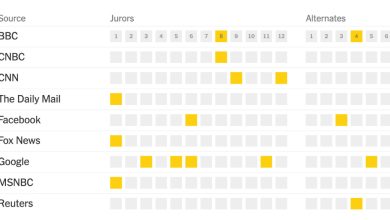A Reporter Explains His Approach to Writing News and Features

Times Insider explains who we are and what we do, and delivers behind-the-scenes insights into how our journalism comes together.
Brooks Barnes’s head is constantly on a swivel.
As a domestic correspondent covering Hollywood’s leading celebrities, companies and executives for The New York Times, he writes both daily news articles about media companies and long-lead features about subjects such as Walt Disney World’s animatronic robot crew and the Polo Lounge, a Hollywood hot spot that attracts the who’s who of the film industry.
Those two types of articles — news and features — are the yin and yang of journalism. As the name suggests, news articles provide readers with new information about important events, often as they unfold. They can cover nearly any topic, are generally 500 to 1,000 words long and are packed with the need-to-know facts of a given situation. Features, which need not be tied to a specific event, dive deep into a particular topic or person, are usually longer than news articles and often offer more comprehensive context about their subjects.
Every day, The Times publishes both. While many journalists specialize in writing news or feature articles, Mr. Barnes flips between the two.
“I have eight to 10 features on the assembly line at any given time,” Mr. Barnes said, adding that he often has to drop what he’s working on to chase the news and that he focuses on writing features when the news is slow. Generally, he can finish a news article in a couple of hours or less; a major feature can take upward of six months.
For Mr. Barnes, the main difference between a news article and a feature isn’t the word count, the number of interviews involved or how long he spends drafting it: “The writing process changes,” he says.
Interviewing Sources
A news article is all about gathering the essential information and publishing quickly.
He begins working on a news article by making calls to sources, often contacts he has built up over more than 20 years of reporting. He says he jots down his most important questions before he calls a source, even if he’s on a deadline and knows the conversation will only last a few minutes.
For a feature, Mr. Barnes said he will do around 10 interviews, not all of which may appear in the final article. If he’s writing a profile, he aims to spend a few hours with his subject on a Friday or Saturday, when the person is more relaxed and available.
As with news articles, he writes out his interview questions in advance, though he tries not to do too much research before meeting a profile subject for the first time so that he won’t come into the interview with a preconceived idea of what the subject might say.
“You want to report, not interview your thumb,” he said.
Getting Down to Writing
Mr. Barnes never outlines his news or feature articles, but instead works off his notes, which he’ll consult as he’s writing.
He gathers all of his notes from his interviews and research, both typed and handwritten, and inputs the best quotes, facts and figures into a Microsoft Word document. Unlike a news article, a feature may involve several attempts at a compelling first few sentences — known as the lede — and lots of rewriting. “I’ve been known to fixate on a lede for much longer than I should,” he said.
Structurally, a news article is much more straightforward than a feature: In a news article, the most important and timely information appears in the first few sentences, with the remaining facts generally provided in descending order of importance. In a feature, by contrast, the writer often delays the revelation of certain details in order to build suspense.
Landing on the Voice
Another difference, Mr. Barnes said, is the voice that he interjects — or doesn’t — into an article. A news article is usually devoid of personal flavor, while a feature can be saturated with it. He says he sometimes tries to “self-censor” his voice in a news article. In a feature, there is room for more lyrical description; Mr. Barnes is able to dwell on how a subject dresses, talks and reacts to his questions.
Working on Edits
The editing process also differs. With features, it can involve lots of fine-tuning: Ledes may be thrown out and paragraphs rewritten. With a news article, an editor acts more like a safety net than a pruner or a polisher, ensuring that reporters on deadline aren’t overlooking important information or relevant questions, and that they aren’t committing any obvious factual errors.
Enjoying Both Forms
The greatest challenge in writing a news article, in Mr. Barnes’s opinion, is achieving both speed and accuracy on deadline. Features present a different conundrum: A writer must carefully condense hours of interviews and research into a gripping-yet-accurate narrative that doesn’t get bogged down with superfluous information.
Though Mr. Barnes says he enjoys both forms, he’s always had a clear preference.
“I’m a feature writer who’s somehow managed not to get fired as a business reporter for 20 years,” he said.
He added: “I like luxuriating over words and trying different stuff. I could tinker with a story forever.”




